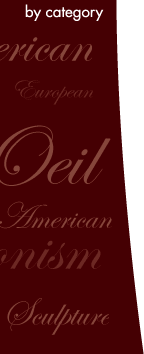
Other regular members of the group are the art historian and critic John Spike and the artist Daniel Graves from Florence, the publisher Christopher Forbes from New York, and the artists John Morra and Randy Melick, but they could not be in New York on January 11th.
PART II – INDIVIDUAL POSTSCRIPTS [TO BE CONTINUED…..]
RANDY MELICK: As the slowest artist on God's green earth bar none, I cannot help but like this manifesto.
I read something I liked recently in the NYTimes that may be germain. The story was on a symposium/master class that a composer was giving to preview a new work of his. After listening to the new work, a student asked whether the piece might have been made "more traditional." The composer replied that a musician, by receiving training in a tradition and gaining proficiency in its forms, gains admittance into that tradition. Once there, however, THE ARTIST OWNS THE TRADITION, and truly is the master of it, and can go on to do with the tradition whatever he/she feels fit -- extend it, preserve it, bend it, overturn it, challenge it; whatever is within the imaginative capacity of that artist to envision and carry off.
What I like about this -- and I think this is implied in the manifesto -- is that it gives primacy to the autonomy of the artist. It acknowledges the importance of training -- of being held accountable to standards already set -- but makes clear that genuine artists are the ones who go on to create the new, hitherto unimaginable standards by which they will ultimately be judged. In training, artists are accountable to a tradition; from there, tradition is accountable to the artist.
R.M.
GREGORY HEDBERG: I am a New Yorker who has a hard time adjusting to the slower pace of any city outside of New York. Personally, I crave a fast pace. Nevertheless, for better or worst, slowness is an inherent aspect of this type of art and I have, slowwwwwwly, become resigned to it.
This was not always the case. In 1987, when I became the first professional Director of the New York Academy of Art, one of the very first of the new art schools going ‘back to the future,’ I thought that very quickly this new academy would spawn a number of great artists and hundreds of great paintings. Frankly, five years later when I left the Academy, I thought it had been a noble experiment that perhaps had failed. About five years after that, however, I attended a Paint Group evening at the home of Jacob Collins, where we spent – to my amazement – about three hours looking at only five paintings, all works recently made by the young artists in the group. This evening not only enlightened me to the fact that the traditional training at the Academy was at last beginning to produce some excellent artists, but that the total absorption of the skills necessary to produce such art took a very, very, very long time to acquire. Moreover, to then totally master such skills – to the point of liberation – also required insights and input from other artists. Hence I later launched what came to be called Artists’ Nights that focused on the artists, while also on occasion mixing in curators and others from the New York art world. I have also come to be totally resigned to just how slowly these artists work, but now the wait is well worth it.
As to the manifesto, I hope that it does not in any way imply that all slow art is highly significant, for, in fact, much of what is being produced, particularly amongst those with very little or improper training in fundamentals like drawing, or lesser ability, can be quite ordinary, especially those ‘pseudo-slow’ artists, if you will, who simply paint from photographs. Here I tend to agree with Chuck Close who said: “One of the interesting things about the difference between abstraction and representation is that a really bad abstract painting will easily become meaningless background for cocktail chitchat; it just becomes wallpaper. But you can’t stop looking at a bad figurative painting. It’s like a sore thumb. The reason involves the different ways the two things fail: bad abstraction fails because it’s meaningless decoration, but it’s never as grating as bad figure drawing.” (Michael Kimmelman, Portraits, 1998, pp. 239-240).
I also hope that it is clear that this group wants to revive the quality and skills of the art of the past – but not the art of the past itself. As my resume can attest, I have and still champion various modern artists from Picasso to Sol Lewitt, and now also look forward to seeing the full flowering of this Slow Art of the future. While manifestos are important to articulate commonly held beliefs – the works of art must now speak for themselves, which I think they do with vitality and beauty.
As everyone knows, over the past century the definition of art has expanded again and again. Now, with this new Slow Art movement, born in the heart of the fastest paced city in the world, the definition of art is happily once again being expanded.
G.H.


3005 Peachtree Road, NE, Suite B
Atlanta, GA 30305